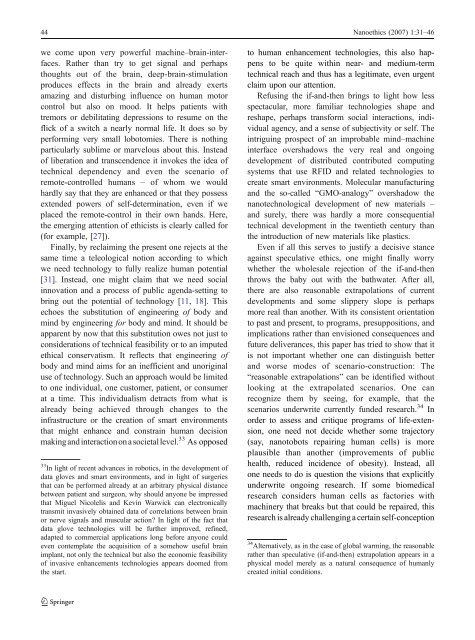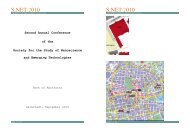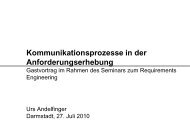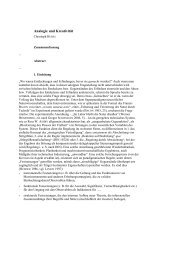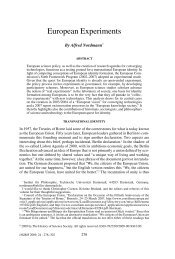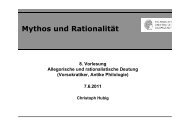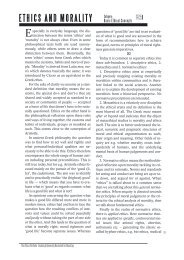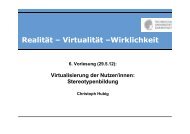If and Then: A Critique of Speculative NanoEthics - Common Sense ...
If and Then: A Critique of Speculative NanoEthics - Common Sense ...
If and Then: A Critique of Speculative NanoEthics - Common Sense ...
Create successful ePaper yourself
Turn your PDF publications into a flip-book with our unique Google optimized e-Paper software.
44 Nanoethics (2007) 1:31–46<br />
we come upon very powerful machine–brain-interfaces.<br />
Rather than try to get signal <strong>and</strong> perhaps<br />
thoughts out <strong>of</strong> the brain, deep-brain-stimulation<br />
produces effects in the brain <strong>and</strong> already exerts<br />
amazing <strong>and</strong> disturbing influence on human motor<br />
control but also on mood. It helps patients with<br />
tremors or debilitating depressions to resume on the<br />
flick <strong>of</strong> a switch a nearly normal life. It does so by<br />
performing very small lobotomies. There is nothing<br />
particularly sublime or marvelous about this. Instead<br />
<strong>of</strong> liberation <strong>and</strong> transcendence it invokes the idea <strong>of</strong><br />
technical dependency <strong>and</strong> even the scenario <strong>of</strong><br />
remote-controlled humans – <strong>of</strong> whom we would<br />
hardly say that they are enhanced or that they possess<br />
extended powers <strong>of</strong> self-determination, even if we<br />
placed the remote-control in their own h<strong>and</strong>s. Here,<br />
the emerging attention <strong>of</strong> ethicists is clearly called for<br />
(for example, [27]).<br />
Finally, by reclaiming the present one rejects at the<br />
same time a teleological notion according to which<br />
we need technology to fully realize human potential<br />
[31]. Instead, one might claim that we need social<br />
innovation <strong>and</strong> a process <strong>of</strong> public agenda-setting to<br />
bring out the potential <strong>of</strong> technology [11, 18]. This<br />
echoes the substitution <strong>of</strong> engineering <strong>of</strong> body <strong>and</strong><br />
mind by engineering for body <strong>and</strong> mind. It should be<br />
apparent by now that this substitution owes not just to<br />
considerations <strong>of</strong> technical feasibility or to an imputed<br />
ethical conservatism. It reflects that engineering <strong>of</strong><br />
body <strong>and</strong> mind aims for an inefficient <strong>and</strong> unoriginal<br />
use <strong>of</strong> technology. Such an approach would be limited<br />
to one individual, one customer, patient, or consumer<br />
at a time. This individualism detracts from what is<br />
already being achieved through changes to the<br />
infrastructure or the creation <strong>of</strong> smart environments<br />
that might enhance <strong>and</strong> constrain human decision<br />
making<strong>and</strong>interactiononasocietallevel. 33 As opposed<br />
33 In light <strong>of</strong> recent advances in robotics, in the development <strong>of</strong><br />
data gloves <strong>and</strong> smart environments, <strong>and</strong> in light <strong>of</strong> surgeries<br />
that can be performed already at an arbitrary physical distance<br />
between patient <strong>and</strong> surgeon, why should anyone be impressed<br />
that Miguel Nicolelis <strong>and</strong> Kevin Warwick can electronically<br />
transmit invasively obtained data <strong>of</strong> correlations between brain<br />
or nerve signals <strong>and</strong> muscular action? In light <strong>of</strong> the fact that<br />
data glove technologies will be further improved, refined,<br />
adapted to commercial applications long before anyone could<br />
even contemplate the acquisition <strong>of</strong> a somehow useful brain<br />
implant, not only the technical but also the economic feasibility<br />
<strong>of</strong> invasive enhancements technologies appears doomed from<br />
the start.<br />
to human enhancement technologies, this also happens<br />
to be quite within near- <strong>and</strong> medium-term<br />
technical reach <strong>and</strong> thus has a legitimate, even urgent<br />
claim upon our attention.<br />
Refusing the if-<strong>and</strong>-then brings to light how less<br />
spectacular, more familiar technologies shape <strong>and</strong><br />
reshape, perhaps transform social interactions, individual<br />
agency, <strong>and</strong> a sense <strong>of</strong> subjectivity or self. The<br />
intriguing prospect <strong>of</strong> an improbable mind–machine<br />
interface overshadows the very real <strong>and</strong> ongoing<br />
development <strong>of</strong> distributed contributed computing<br />
systems that use RFID <strong>and</strong> related technologies to<br />
create smart environments. Molecular manufacturing<br />
<strong>and</strong> the so-called “GMO-analogy” overshadow the<br />
nanotechnological development <strong>of</strong> new materials –<br />
<strong>and</strong> surely, there was hardly a more consequential<br />
technical development in the twentieth century than<br />
the introduction <strong>of</strong> new materials like plastics.<br />
Even if all this serves to justify a decisive stance<br />
against speculative ethics, one might finally worry<br />
whether the wholesale rejection <strong>of</strong> the if-<strong>and</strong>-then<br />
throws the baby out with the bathwater. After all,<br />
there are also reasonable extrapolations <strong>of</strong> current<br />
developments <strong>and</strong> some slippery slope is perhaps<br />
more real than another. With its consistent orientation<br />
to past <strong>and</strong> present, to programs, presuppositions, <strong>and</strong><br />
implications rather than envisioned consequences <strong>and</strong><br />
future deliverances, this paper has tried to show that it<br />
is not important whether one can distinguish better<br />
<strong>and</strong> worse modes <strong>of</strong> scenario-construction: The<br />
“reasonable extrapolations” can be identified without<br />
looking at the extrapolated scenarios. One can<br />
recognize them by seeing, for example, that the<br />
scenarios underwrite currently funded research. 34 In<br />
order to assess <strong>and</strong> critique programs <strong>of</strong> life-extension,<br />
one need not decide whether some trajectory<br />
(say, nanotobots repairing human cells) is more<br />
plausible than another (improvements <strong>of</strong> public<br />
health, reduced incidence <strong>of</strong> obesity). Instead, all<br />
one needs to do is question the visions that explicitly<br />
underwrite ongoing research. <strong>If</strong> some biomedical<br />
research considers human cells as factories with<br />
machinery that breaks but that could be repaired, this<br />
research is already challenging a certain self-conception<br />
34 Alternatively, as in the case <strong>of</strong> global warming, the reasonable<br />
rather than speculative (if-<strong>and</strong>-then) extrapolation appears in a<br />
physical model merely as a natural consequence <strong>of</strong> humanly<br />
created initial conditions.


